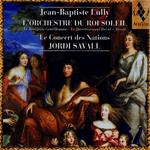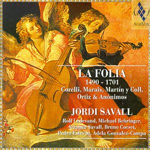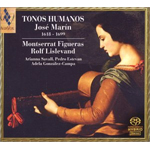|
You are reading the older HTML site Positive Feedback ISSUE 8 august/september 2003
Another Voice
A while back, a very intelligent friend of mine, frustrated at not being able to find his way into ‘early' classical music, asked me for advice on entry points. Since he had done the same for me on the far more formidable subject of cognitive science, I was eager to oblige. I gave him one word: Jordi Savall. For those of you in a similar quandary, I offer the same advice. Several years ago, this eminent and magnetic Spanish performer on the viol and music entrepreneur, having produced an extraordinarily popular oeuvre of renaissance, baroque, and early classical recordings on the French Astree label, left to establish his own label, presumably to gain more artistic control. It is evident now that he wanted to make clearer his mission as both performer and maker of recordings: to establish the distinctive identity of ‘another voice' in music interpretation. The Spanish voice or, more properly, Jordi Savall's Spanish voice. The result is the label Alia Vox and the fruits thus far have been rich. There are some musicologists around who find Savall's approach in general and his viol playing in particular 'inauthentic': in a word, over the top in sensuality and panache. Listening to his performances head to head with the competition, I am generally too swept up in the music to quibble. To my ears he instinctively knows where the heart of a piece is and embraces it, whether it be Beethoven's Third Symphony, Bach's Orchestral Suites, or Couperin's (or Marais's or Sainte Columbe's) Viol Suites. Does he put the Jordi Savall stamp on music? Of course. That's what great musicians (used to) do. As a fan of Savall, and a still open-minded inquirer about the importance of the SACD phenomenon, I was especially curious to explore several of his fairly recent releases that have been reissued as SACD hybrids. To be fair, these are PCM, not DSD, recordings, which some SACD aficionados claim does not show off SACD at its best. Noted. Carlos V, Mille Regret, La Cancion del Emperador
The star of this group of recordings is Carlos V, one of the concept albums Savall loves to make, which amount to programmatic concerts he takes on the road in the spirit of musical lessons. This is the kind on concept that would be a disaster in the hands of anyone without Savall's imagination, passion, and musical taste.
The results of this effort are musically quite extraordinary, and I urge both Savall's fans and critics as well as newcomers to gamble on it. Composers represented include Isaac, Josqiun, Cabezon, and Morales. The concert runs the gamut from deeply spiritual to wildly celebratory. Some SACD supporters have complained that "PCM artifacts" show through the conversion to DSD on this recording, in particular on the male choral voices; and after listening to the excerpts they single out, I get their point. There is a slight dryness or crisp bark to the sound in choral passages. But the gains provided by the SACD process here, especially in the retrieval of space, strike me as worth the marginal cost, mainly because the gains are musically significant. This recording was made in la iglesia de San Jeronimo el Real in Madrid and on the SACD, the music literally floats out into a huge space. In the second piece on the recording, by Heinrich Isaac, this is clearly what the composer intended: it makes the difference between being merely (!) beautiful, as it is on the redbook CD version, and as close to spiritual as I've yet to hear on a recording. Jean-Baptiste Lully, L'Orchestra du Roi Soleil
Handel the German went to England by way of Italy to become the heart and soul of British baroque music. Jean Baptiste Lully the Italian went to France, albeit at a younger age, and became the heart if not quite the soul of the French Baroque, though his Petits Motets win him a few strong spiritual points as well. To hear Jordi Savall get his hands on Marais' and Couperin's viol suites is to understand how important it is not to leave a culture's music exclusively to its own people. Moral: I love American but French convert William Christie's Lully, but Savall's is a lot more fun. Jordi lets us hear the spirit of the dance that is at the center of the Sun King's favorite composer, perhaps finding the Italian under the French immigrant. This is another of the recordings where SACD is a bit more atmospheric and smoother in the highs than its CD counterpart. One interesting item of note: for these auditions, my reference Blue Circle AG3000 preamp off to Innerkip, Ontario for its annual checkup by Doctor Yeung, I had an Audio Note M5 single-ended tubed preamp visiting my system, which turned out to be a splendid match for the Audience/Sony CD/SACD player. Its fuller and, for lack of a better word, more balmy presentation brought out the heretofore somewhat latent expressive powers of the Audience player. Great synergy. This article isn't about gear, but if you have even considered the Audience/Sony as your CD/SACD choice—and if you're not ready to spend $15,000 you certainly should—be sure to audition it with a high quality, if possible single-ended (the A/S player is also single-ended), preamp. La Folia, 1490-1701
Assembling a selection of music based on the evidently medieval dance song ‘La Folia,' is not a new idea—I remember at least one other, on Hyperion by the Purcell Quartet years ago (still available) featuring all baroque composers. But this one, partly because it gives us some strong early 15th and 16th century versions before getting to the better known Corelli and Marais numbers—is a lot more interesting. A little bit of baroque ‘la folia' goes a long way! Here is a case where I found I preferred the redbook CD to the SACD. It has less venue, as expected, but seems more intimate and engaging as a result. That, I've found, is frequently the trade-off when you go from CD to SACD. The huge space in the SACD on this recording is very dramatic but also a bit distracting. A matter of taste, I guess. (Some folks prefer mono to stereo for a similar reason!) To anticipate SACD critics, it is not that the spatial effects here seemed artificial. They just didn't add anything musically significant to the proceedings—to the contrary. Given the benefits of the spatial effects on the Carlos V record, I am clearly not about to draw any significant conclusions on the medium at this point! Jose Marin, Tonos Humanos, 1618-1699
The luxury of being Jordi Savall is that you can champion the rich and irresistible voice of your wife, Montserrat Figueras, and a 17th century ‘singer-songwriter,' Jose Marin, at the same time, defeating the usual laws of the marketplace and scoring a musical triumph. Savall does not perform on this recording, but his spirit presides. And his daughter, Arianna Savall, makes what I believe is her first appearance on record, playing the arpa doppia (double harp). (She has just released her own CD on the Mirare label, Sopra la Rosa, a collection of cantatas on the theme of the rose, which reveal, I'm told, that "she has the genes.") Guitarist Rolf Lislevand, percussionist Pedro Estevan, and castonettist (?) Adela Gonzalez-Campa, complete the zesty and spirited quintet. Truly captivating music all. Percussion, including bells, sparkle spectacularly on the SACD in a large space. Figuras's voice seems more ‘complete' if less pure and intimate. There is more air around her top register – she sounds more brilliant. Smooth but brilliant. On redbook, it is all less dramatic and spectacular, her voice is less brilliant. So there they are. As for Jordi Savall on Alia Vox, this is just the tip of the iceberg. I recommend also his Elizabethan Consort Music, a companion recording, The Consort Music of William Lawes (CD and SACD); his Les Voix Humaines, which explores the voice of the bass viol; the soundtrack from the deliciously sentimental film on the life of Marais, Tous les matin du monde, which features the viol music of Marais and Sainte Columbe (newly remastered in its move from Astree to Alia Vox); a newly recorded collection of viol music by both Marais and Sainte Colombe called La Parnass de la Viole; Bach's Art of the Fugue, played by a chamber group from Savall's orchestra, Hesperion XX (the best version I've heard if you don't restrict yourself to versions for the keyboard—the individual voices are wonderfully clear on strings); and a double album which offers his recording of Bach's Orchestral Suites and Brandenberg Concertos, both former Astree releases. There are also a goodly number of Savall recordings still on Astree, including his Beethoven Third Symphony, which must not be missed.No word yet whether these jewels, other than the Lawes recording, will follow the others reviewed here onto SACD, but don't let that stop you. As I say, especially with these PCM based recordings, the differences are not critical and the music is too good to miss. If you are looking for a door into early and baroque classical music, entrez! |




